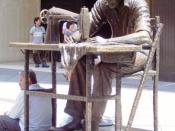During the 1930s, America was fighting the Great Depression and those who did find employment were forced to work for miniscule amounts, and many children were forced to find employment to help out their struggling families. A large majority of those children, who did find employment, were forced to work many hours for barely a livable wage. "The Fair Labor Standards Act of 1938 (FLSA) was enacted to establish standards for minimum wages, overtime pay, employer recordkeeping, and child labor" (Bennett-Alexander & Hartman, 2007).
In those times, the FLSA established a twenty-five cents minimum wage, and mandated a 40-hour workweek. Any time spent over 40 hours per week paid out as time and a half. "The original intent of the FLSA was to decrease the advantage that lower-paying southern factories had over northern factories. Puerto Rico was devastated as a result of the new law because unemployment resulted there through the sheer inability of important industries to pay the twenty-five cents an hour" (Bovard, 1994).
Some studies suggest that raising the minimum wage results in many layoffs throughout the country. When Congress raised the minimum wage 46 cents between 1977 and 1981, some estimate that "the minimum wage hikes resulted in the loss of 644,000 jobs, including jobs that were not created" (Bovard, 1994). Some estimate that as a result of the minimum wage laws that "Teenage workers have greater job losses, relative to their share of the population or the employed work force, than adults" (Bovard 1994).
Interestingly enough, the FLSA has it's roots all the way back in 1900 when the International Ladies' Garment Workers' Union (ILGWU), began protesting 15 hour workdays, low pay, lack of benefits and unsafe working conditions. In 1909, 20,000 shirtwaist makers consisting mainly of women and children began to strike. Many workers were...


